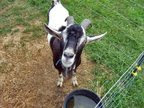Sometime in your life as a goat-raiser, you will have to perform midwife duties on your raised animals. By this time, you may have mastered goat care. It is time to learn basic newborn baby goat care.
Infant mortality among goat kids are most pronounced in the wild where only the doe’s instincts are at work. You will fill in what Mother Nature sometimes forgets in the wild.
First minutes
You are there to help, not to take charge. On their own, the doe and the newborn can both manage. You are there, your disinfected hands in your sterile gloves, only to extend help in extreme situations.
When the kid comes out, it is wet, enclosed in a membrane, and most of the time, looking thoroughly lifeless. Do not panic.
Generally, the mother doe will lick the mucus clean off the kid. This also helps stimulate the newborn’s breathing. Maybe you can help wipe it off as well with a clean towel.
It is not necessary to cut the umbilical cord. (It will eventually fall off.) If there is excessive bleeding, tie it with dental floss. Dip it in 7% iodine solution for infection protection.
In a half-hour, the kid will try to stand up and nurse. Do an initial few forceful milking actions on both the doe’s teats to remove blockages. Guide the kid (or kids) to the teats.
Clean as you go. Your job is done.
Worst case scenario
If breathing has not started at all or is labored (with sounds of noisy liquid), help the mother clean the kid fast. Carefully reach into the mouth, however you can, and towel off any fluids in there.
If things have not improved, you may use a syringe to suck out the mucus and other fluids from the nose and mouth. You may even grab the kid by its hind legs with a towel and let it hang for a short time to drain some of the fluids.
(Others say that farmers of old used to tie the newborn’s hind legs onto a fence to drain out the fluids. In the movies, they twirl the kid in the air while holding the hind legs.)
When breathing starts going with no more sound, calmly rub its body to stimulate more vigorous breathing and help the circulation.
After birth
After giving birth, move the doe and the kids to a clean, dry place away from the rest of the herd. This is the time of rest and ‘bonding’ for the mother and the kids. (Be on alert for the sudden unexplainable maternal aggression that sometimes happens.)
After two or three days, they can join the rest. By this time, the kids are strong enough not to be trampled or injured.
Other necessities
The newborn kids should have anti-tetanus shots just before dehorning which should happen before the kids reach ten days old. Dehorning is also the time for neutering the males to become wethers.
Newborn baby goat care need not be traumatic for the owner and the goats, nor should it be. Presence of mind, patience, and some love are all there is needed.






No comments:
Post a Comment